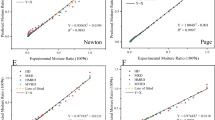Abstract
Onion powder has an extensive demand and wide application worldwide as flavour additive in convenience foods and medicinal products. Conventionally onion powder is prepared by hot air drying of onion slices followed by grinding. Convective air drying when used alone demands longer drying time and thus has a high expense of energy. As bulk of onion is water (82–87 %), removal of moisture prior to drying can reduce moisture loading on dryer and hence the energy consumption. Keeping this in view, onions were partially dewatered using centrifugal force before convective drying. The effect of partial mechanical dewatering and drying air temperature was studied on drying time, specific energy consumption and onion powder quality (colour and flavour). The combination process was also optimized to achieve increased drying rate and product quality comparable to products obtained using convective drying alone. Onions subjected to 60 % partial mechanical dewatering and hot air drying at 70 °C exhibited significantly (p ≤ 0.5) shortened drying time, decreased energy consumption and maintained colour and flavour of the dried product.



Similar content being viewed by others
References
Anthon GE, Barrett DM (2003) Modified method for the determination of pyruvic acid with DNPH in the assessment of onion pungency. J Sci Food Agric 83:1210–1213
AOAC (1990) Official Methods of Analysis (15th edition). Association of Official Analytical Chemists, Arlington
Arabhosseini A, Padhye S, Huisman W, Boxtel A, Müller J (2010) Effect of drying on the color of Tarragon (Artemisiadracunculus L.) leaves. Food Bioprocess Tech 4:1281–1287
Aversa M, Curcio S, Calabrò V, Iorio G (2010) Experimental evaluation of quality parameters during drying of carrot samples. Food Bioprocess Tech 5:128–129
Bureau of Energy Efficiency (BEE) (2004) Best practice manual: dryers. New Delhi, India. http://www.energymanagertraining.com/bee_draft_codes/best_practices_manual-DRYERS.pdf. Accessed 22 August 2009
Doymaz I, Tugrul N, Pala M (2006) Drying characteristics of dill and parsley leaves. J Food Eng 77:559–565
Energy Efficiency Best Practice Programme (EEBPP) (1996) Rotary drying in the food and drink industry, good practice guide, pp 149. Carbon Trust. www.energystar.gov/ia/business/industry/Food-Guide.pdf. Accessed 22 August 2009
Fenwick RG, Hanley AB (1990) Processing of Alliums: Use in food manufacture. In: Brewster JL, Rabinowitch HD (eds) Onions and allied crops: biochemistry, food science and minor crops, vol III. CRC press, Boca Raton, pp 74–88
Gigler JK, Loon WKP, An Seres I, Meerdink G, Coumans WJ (2000) Drying characteristics of willow chips and stems. J Agric Eng Res 77(4):391–400
Gowen AA, Abu-Ghannam N, Frias J, Oliveira J (2008) Modeling dehydration and rehydration of cooked soybeans subjected to combined microwave–hot-air drying. Innov Food Sci Emerg Technol 9:129–137
Hu QG, Zhang M, Mujumdar AS, Xiao GN, Jin-cai S (2006) Drying of edamames by hot air and vacuum microwave combination. J Food Eng 77(4):977–982
Iowa State University (ISU) (2005) Energy-related best practices: a sourcebook for the food industry. Iowa State University Extension Program, Ames
Kaymak-Ertekin F, Gedik A (2005) Kinetic modelling of quality deterioration in onions during drying and storage. J Food Eng 68:443–453
Koyuncu T, Serdar U, Tosun I (2004) Drying characteristics and energy requirement for dehydration of chestnuts (Castanea sativa Mill.). J Food Eng 62:165–168
Krokida MK, Maroulis ZB (1999) Effect of microwave drying on some quality properties of dehydrated products. Dry Technol 17:449–466
Kumar Parveen DG, Hebbar HU, Sukumar D, Ramesh MN (2005) Infrared and hot-air drying of onions. J Food Process Preserv 29:132–150
Lenart A, Iwaniuk B, Lewicki PP (1993) Water transfer during rehydration of dewatered apple, pumpkin and carrot. In: Properties of water in foods. Warsaw Agricultural University Press, pp 118–129
Liu K (1998) Food research and data analysis. Chinese Light Industry, Beijing
Madamba PS, Bekki E (2001) Optimization of the vacuum dehydration of carrot (Daucus carota, L.) strips. American Society of Agricultural Engineers (ASAE) Annual Convention (ASAE Paper no: 2001–6065). Sacramento Convention Center, Sacramento
Masanet E, Worrell E, Graus W, Galitsky C (2008) Energy efficiency improvement and cost saving opportunities for the fruit and vegetable processing industry: an ENERGY STAR® guide for energy and plant managers. Environmental Energy Technologies Division, University of California, Berkeley
Maskan M (2001) Kinetics of colour change of kiwifruits during hot air and microwave drying. J Food Eng 48:169–175
Mongpraneet S, Abe T, Tsurusaki T (2002) Accelerated drying of Welsh onion by far infrared radiation under vacuum conditions. J Food Eng 55:147–156
Mudahar GS, Toledo RT, Jen JJ (1990) A response surface methodology approach to optimize the potato dehydration process. J Food Process Preserv 14:93–106
Pathare PB, Sharma GP (2006) Effective moisture diffusivity of onion slices undergoing infrared convective drying. Biosyst Eng 93(3):285–291
Prabhanjan DG, Ramaswamy HS, Raghavan GSV (1995) Microwave assisted convective air drying of thin layer carrots. J Food Eng 25:283–293
Rapusas RS, Driscoll RH (1995) The thin layer drying characteristics of white onion slices. Dry Technol 13:1905–1931
Revaskar V, Sharma GP, Verma RC, Jain SK, Chahar VK (2007) Drying behaviour and energy requirement for dehydration of white onion slices. Int J Food Eng 3(5):14. doi:10.2202/1556-3758.1077
Sarsavadia PN, Sawhney RL, Pangavhane DR, Singh SP (1999) Drying behaviour of brined onion slices. J Food Eng 40:219–226
Schwimmer S, Wetson WJ (1961) Enzymatic development of pyruvic acid in onions as a measure of pungency. J Agric Food Chem 9:301–304
Sharma GP, Verma RC, Pathare P (2005) Mathematical modeling of infrared radiation thin layer drying of onion slices. J Food Eng 71:282–286
Vergara F, Amezaga E, Barcenas ME, Welti J (1997) Analysis of the drying processes of osmotically dehydrated apple using the characteristic curve model. Dry Technol 15:949–963
Acknowledgments
Financial support received from Indian Council of Agricultural Research (ICAR) and facilities provided by Central Institute of Post Harvest Engineering and Technology (CIPHET) for this research are gratefully acknowledged.
Author information
Authors and Affiliations
Corresponding author
Rights and permissions
About this article
Cite this article
Grewal, M.K., Jha, S.N., Patil, R.T. et al. A less energy intensive process for dehydrating onion. J Food Sci Technol 52, 1131–1137 (2015). https://doi.org/10.1007/s13197-013-1092-x
Revised:
Accepted:
Published:
Issue Date:
DOI: https://doi.org/10.1007/s13197-013-1092-x




